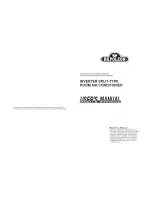
ESIE16-02K
|
Part 1. Introduction
1.2. Safety precautions
31/05/21
|
Version 1.0
Page 11
RA R32 Split & multi split M-Series
W
ARNING
Make sure installation, testing and applied materials comply with applicable legislation (on top of the instructions
described in the Daikin documentation).
W
ARNING
Make sure the work site environment is clean and safe to work in. Beware of spilled fluids, like water, oil or other sub-
stances. Protect bystanders from injury and property from possible damage cause by service works.
W
ARNING
Wear adequate personal protective equipment (protective gloves, safety glasses,…) when installing, maintaining or ser-
vicing the system.
W
ARNING
Tear apart and throw away plastic packaging bags so that nobody, especially children, can play with them. Possible risk:
suffocation.
W
ARNING
Do NOT touch the air inlet or aluminium fins of the unit.
W
ARNING
• Do NOT place any objects or equipment on top of the unit.
• Do NOT sit, climb or stand on the unit.
W
ARNING
During tests, NEVER pressurize the product with a pressure higher than the maximum allowable pressure (as indicated
on the nameplate of the unit).
W
ARNING
• Never mix different refrigerants or allow air to enter the refrigerant system.
• Never charge recovered refrigerant from another unit. Use recovered refrigerant only on the same unit where it was
recovered from, or have it recycled at a certified facility.
W
ARNING
: R
ISK
OF
F
IRE
• When reconnecting a connector to the PCB, do not apply force or damage the connector or the connector pins on the
PCB.
W
ARNING
: R
ISK
OF
BURNING
• Do NOT touch the refrigerant piping, water piping or internal parts during and immediately after operation. It could be
too hot or too cold. Give it time to return to normal temperature. If you must touch it, wear protective gloves.
• Do NOT touch any accidental leaking refrigerant.
W
ARNING
Always recover the refrigerants. Do NOT release them directly into the environment. Use a recovery pump to evacuate
the installation.
Take sufficient precautions in case of refrigerant leakage. If refrigerant gas leaks, ventilate the area immediately.
Possible risks:
• Excessive refrigerant concentrations in a closed room can lead to oxygen deficiency.
• Toxic gas may be produced if refrigerant gas comes into contact with fire.
Where applicable, pump down the system and close the service valve, before leaving the site if leak was not repaired, to
avoid further leaking of the refrigerant.
W
ARNING
: R
ISK
OF
ELECTROCUTION
• Turn OFF all power supply before removing the switch box cover, connecting electrical wiring or touching electrical
parts. Where applicable, stop the equipment's operation first and allow (refrigerant) pressure to equalize, before
turning OFF the power. Disconnect the power supply for more than 1 minute, and measure the voltage at the
terminals of main circuit capacitors or electrical components before servicing. The voltage must be less than 50 V DC
before you can touch electrical components. For the location of the terminals, refer to
• Do NOT touch electrical components with wet hands.
• Do NOT leave the unit unattended when the service cover is removed.
• Protect electric components from getting wet while the service cover is opened.












































